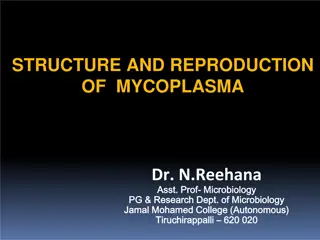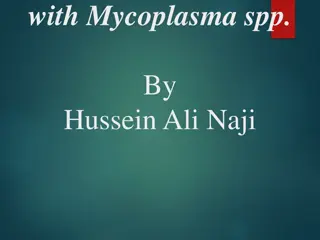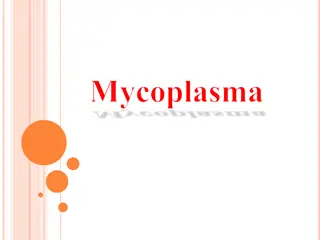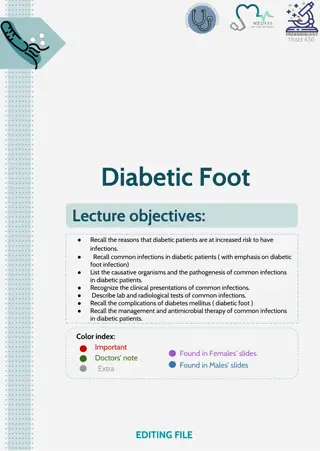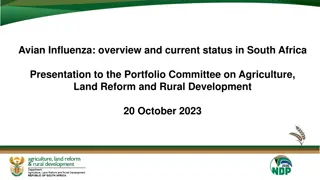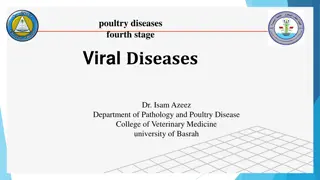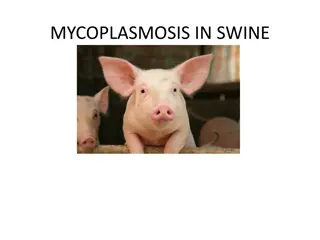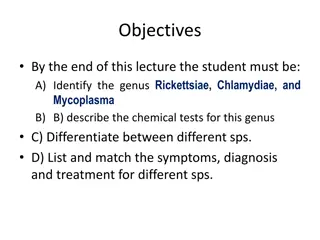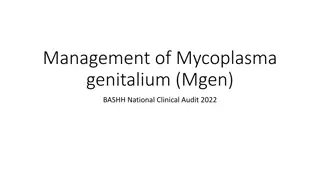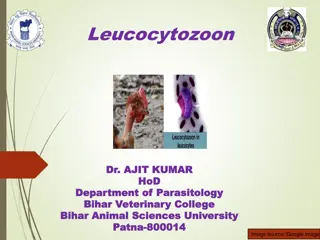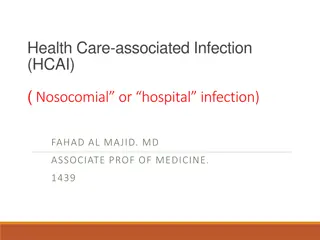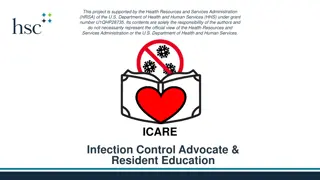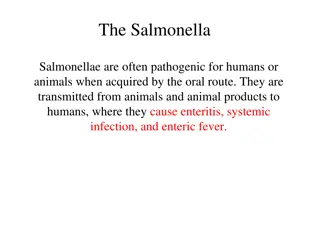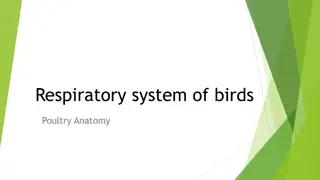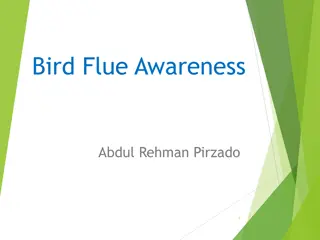Understanding Mycoplasma Infections in Avian Species
Mycoplasma infections, caused by species like Mycoplasma gallisepticum and Mycoplasma synoviae, are common in poultry, particularly affecting turkeys and chickens. These infections lead to respiratory issues, sinusitis, and reduced production rates. Learn about transmission, clinical findings, and virulence factors involved in these avian diseases.
Download Presentation

Please find below an Image/Link to download the presentation.
The content on the website is provided AS IS for your information and personal use only. It may not be sold, licensed, or shared on other websites without obtaining consent from the author. Download presentation by click this link. If you encounter any issues during the download, it is possible that the publisher has removed the file from their server.
E N D
Presentation Transcript
1.Mycoplasma gallisepticum infection 2. Mycoplasma synoviae Infection 3. Mycoplasma meleagridis Infection Unit-5 4th Professional Asst. Professor Dr. Anil Kumar Dept. of VCC BVC, Patna
The Mollicutes (mycoplasmas) are distinguished phenotypically from other bacteria by their minute size and total lack of a cell wall Colony morphology (Broth and Agar) typically has a "fried egg" appearance under low magnification More than 20 Mycoplasma species have been isolated from avian hosts only 4 species are considered pathogenic in poultry M. gallisepticum and M. synoviae are pathogenic for chicken, turkey, and other species, M. meleagridis and M. iowae are pathogenic primarily in turkeys. Airsacculitis due to avian mycoplasmosis is caused by MG, MS and MM
Mycoplasma gallisepticum Infection (Chronic Respiratory Disease, Infectious Sinusitis) It is the most pathogenic organism It affects broiler chickens and species of birds like turkey, pheasants, chukar partridges, peafowl, pigeons, quail, ducks, geese, and psittacine birds Turkeys are more susceptible to M gallisepticum, frequently resulting in swollen infraorbital sinuses and is thus called "infectious sinusitis. Integral membrane surface proteins (adhesins) that attach to receptors on host cells, allowing for colonization and infection, are important virulence factors involved in antigenic variation and immune evasion.
Transmission : Vertically---trans ovarian Horizontally via infectious aerosols and through contamination of feed, water, and the environment, and by human activity on fomites (shoes, equipment, etc.) They remain infected for life and act as carriers or reservoir for infection Flock-to-flock transmission occurs readily by direct or indirect contact: Movement of bird People or Fomites Stressor (Cold weather, poor air quality or crowding, concurrent infections, and some live virus vaccinations) may facilitate infection, disease, and transmission.
Initial colonization occur in epithelium of the conjunctiva, nasal passages, sinuses, and trachea In severe, acute disease, infection may also involve the bronchi, air sacs, and occasionally lungs Clinical Findings : Respiratory distress, with rales, difficulty breathing, coughing, and/or sneezing Nasal discharge and frothiness about the eyes In turkeys the disease is more severe than in chickens, and swelling of the infra-orbital sinuses is common Reduced feed efficiency and weight gains May suffer high condemnations at processing due to airsacculitis In laying flocks Chronic delayed mortality and decrease in the overall production rate clear dried nasal exudate, and a swollen infraorbital sinus. mucoid exudate, conjunctivitis with conjunctivitis, periorbital swelling, and a dried nasal exudate
Concurrent infection with E. coli result in : Severe air sac thickening Turbidity, with exudative accumulations Adhesive pericarditis, Thickened abdominal air sac and cloudy, with blood vessels visible Fibrinous perihepatitis. In Turkeys : Mucopurulent sinusitis tracheitis and airsacculitis Diagnosis: History, clinical signs, and typical gross lesions Serology (agglutination and ELISA) Hemagglutination-inhibition (HI)--as a confirmatory test isolation from swab samples (infraorbital sinuses, nasal turbinates, choanal cleft, trachea, air sacs, lungs, or conjunctiva)
Treatment, Control, and Prevention: Antibiotics (Tylosin, tetracyclines and fluoroquinolones) to reduce egg transmission or as prophylactic treatment to prevent respiratory disease They do not eliminate infection Obtaining chicks or poults from M gallisepticum-free breeder flocks Good biosecurity to prevent introductions Serological monitoring Three live vaccines i.e. F-strain, ts-11, and 6/85 have been used during the growing phase F-strain is of low virulence in chickens but is fully virulent for turkeys A recombinant fowlpox M gallisepticum vaccine used commercially
Mycoplasma synoviae Infection (Infectious Synovitis) Mycoplasma synoviae most commonly causes subclinical upper respiratory infections in chickens, turkeys, and other avian species world wide It is also a complication of airsacculitis in association with Newcastle disease (ND) or infectious bronchitis(IB) Infections of multiple-age layer flocks are common Transmission: Egg transmitted (transovarian) Horizontal transmission-via the respiratory tract Signs and Symptoms: Slight rales Pale-bluish head parts and lameness in many birds with a tendency to sit
Severely affected birds are depressed and found resting around feeders and waterers Swollen hocks and footpads Sternal bursitis (breast blisters) Egg shell abnormalities in egg layers Swollen foot pad and swollen hock joint A creamy to viscous yellow-gray exudate is present in most synovial structures but most commonly seen in swollen hock and wing joints Livers are enlarged and sometimes green Spleens and Kidney are enlarged Viscous yellow exudate in the joint and around the tendons
Diagnosis: Clinical signs and gross lesions Real-time PCR Serum plate agglutination or ELISA are used to detect antibodies Hemagglutination-inhibition or by culture, isolation, and identification of the organism. Treatment, Control, and Prevention: Stock should be obtained from disease free sources and raised with good biosecurity Antibiotics in feed may help reduce synovitis but not very effective in established cases A live, temperature-sensitive vaccine (MS-H) is used, but not commercially avialable
Mycoplasma meleagridis Infection It causes an egg-transmitted (transovarian) disease of breeder turkeys (host-specific) that leads to airsacculitis in the offspring It does not affect chickens Transmission: Vertical (egg) transmission Horizontally via aerosols from the respiratory tract or to the vent Infected semen Manually via contaminated hands, clothing, and equipment or during vaccination Clinical Findings: Reduces hatchability (due to late embryo mortality), poult quality, and growth rate Mild respiratory signs despite of high rates of airsacculitis in poults
Egg-borne infections in turkey have early rapid growth of hock joints, periarticular tissues, vertebrae, and producing skeletal such as crooked (wry) necks or leg deformities Hatched poults airsacculitis with turbidity, foamy yellow exudate, and caseous flecks Diagnosis: Serology, culture, or real-time PCR Airsacculitis in suggests M meleagridis infection cervical bone, adjacent abnormalities may have thickening, Large material indicates inflammation of airsacs amount of caseous day-old poults Source: MSD Veterinary Manual
Disease-free breeding stock and antibiotic treatment Dipping eggs in tylosin or other antibiotic reduces the transmission in infected flocks Injection of a suitable antibiotic at 1 day of age or water medication for the first 5 10 days appeared to reduce infection Note: Mycoplasmas are resistant to antibiotics that act on cell wall, such as penicillin, but are sensitive to tetracyclines (oxytetracycline, chlortetracycline and doxycycline), macrolides (erythromycin, tylosin, spiramycin, lincomycin, and kitasamycin), quinolones (imequil, norfloxacin, enrofloxacin and danofloxacin) or tiamulin For better concentrations in the mucosal membranes of the respiratory and genitourinary tracts, such as tiamulin and enrofloxacin is preffered Avian Mycoplasmosis Update: Brazilian Journal of Poultry Science. 2005 / v.7 / n.1 / 01 - 09


